Posts Tagged ‘rare two pound’
Breakfast (10p) is served! Your Scarcity Index Update…
It’s time for your latest Scarcity Index update, where we reveal the UK’s most sought-after circulation coins of the last three months! As we’ve been able to go out and spend more cash in recent months, how has this impacted our Scarcity Index?
Well there’s been lots of movement across all of our indexes, as new trends have been exposed and one particular coin has moved an impressive 16 spaces!
You can use the updated A-Z 10p, 50p and £2 indexes below to discover how sought-after the coins in your collection really are.
This information has been compiled using data from the Change Checker Swap Centre and presented in the easy to use indexes below, with arrows to signify how many places up or down a coin has moved since the last Scarcity Index.
A-Z 10p Scarcity Index
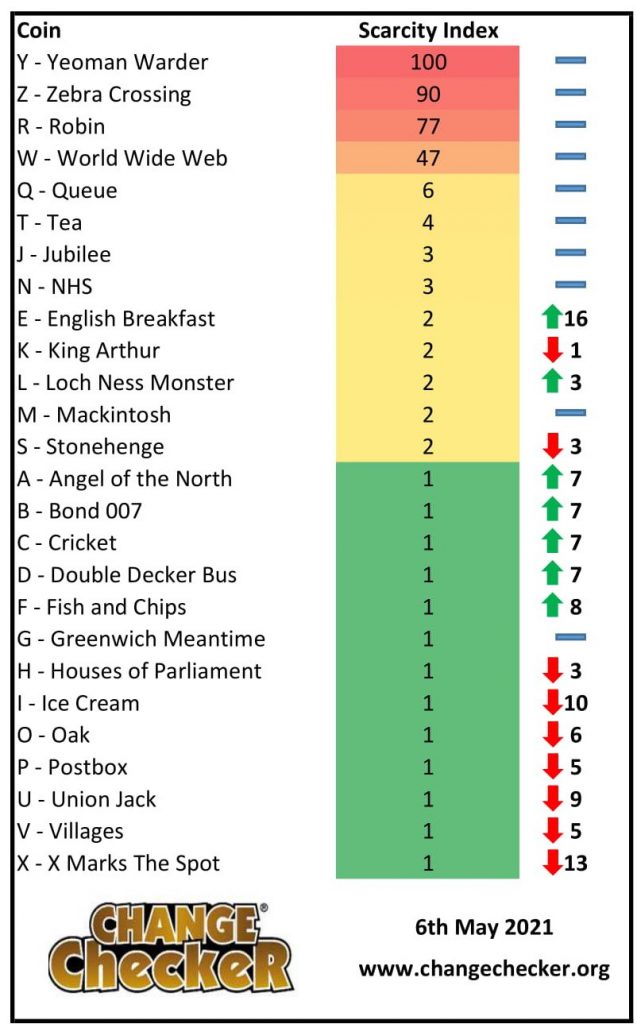
It’s English Breakfast time this quarter as this 10p has climbed a huge 16 places on our A-Z 10p Index! This is definitely the one to watch
Whilst the top 8 spots have stayed the same, there have been some really big movers towards the middle and lower half of the table. The Ice Cream and X Marks The Spot 10ps have both dropped 10 and 13 places respectfully, with other big movers including the Union Jack 10p (dropping nine places) and the Fish and Chips 10p (climbing eight places).
All of the lower mintage A-Z 10ps have remained strong at the top of the index; the Y, Z, and W 10ps all have a 2019 mintage of JUST 63,000 so it would take some doing to beat them to the top…
Regardless of where they feature in the above index, if you have any of the A-Z 10ps in your collection you should consider yourself very lucky. A maximum of only 304,000 of each design entered circulation!
Find out which A-Z 10p coins have the lowest mintages here >>
50p Scarcity Index
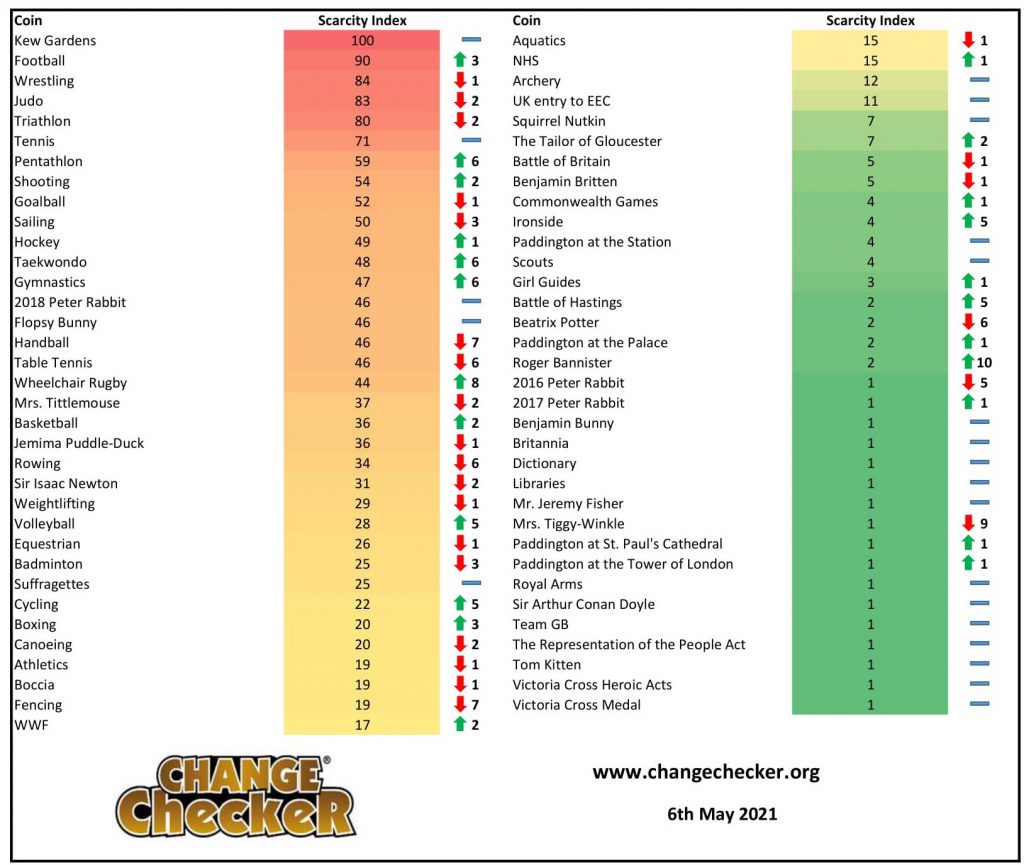
We’ve had a shake up at the top of our 50p Index this quarter, with the Judo 50p being bumped down two spaces from second to fourth spot.
Last quarter our top six 50ps hadn’t moved but this quarter we’ve seen Football climb back to second spot for the first time in three quarters!
There’s also been a lot of shuffling in the middle and lower parts of the index, with Roger Bannister climbing an impressive 10 spots and Handball dropping seven.
The ones to watch are definitely Pentathlon (having climbed 10 places last quarter and a further six this quarter) and Shooting, which climbed two places last quarter and a further two places this quarter. We’re excited to see how these coins place in our next update…
£2 Scarcity Index
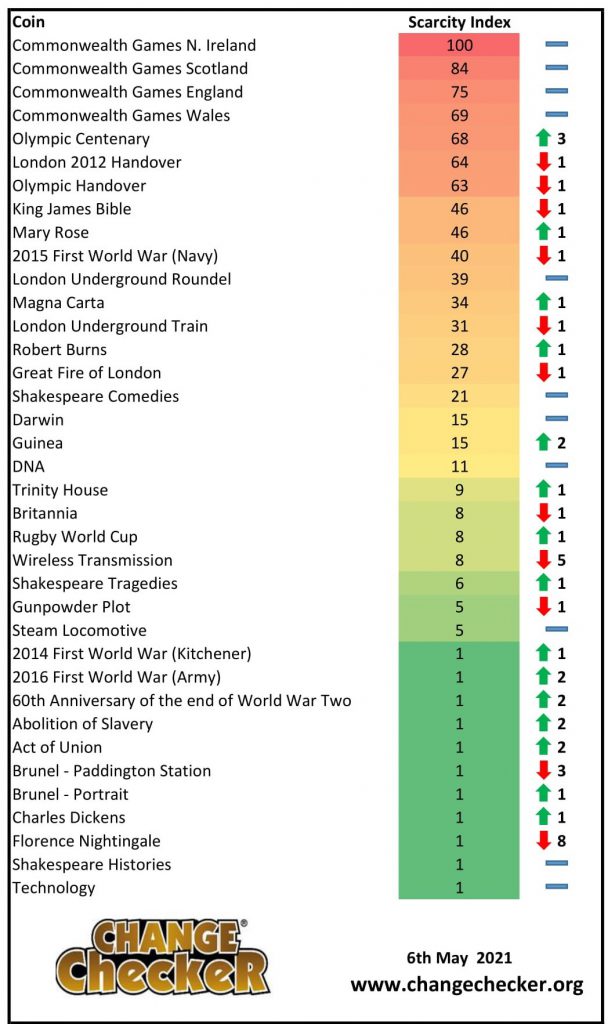
Whilst the Commonwealth Games £2 coins have remained consistent at the top of our Index, we’ve now got our Olympic trio sitting beneath, with the Olympic Centenary climbing 3 places and the London 2012 Handover and Olympic Handover £2 coins coming in behind.
After climbing 8 places last quarter, the Florence Nightingale has dropped back down again to the bottom of the Index.
The First World War (Kitchener) £2 has climbed up a space after also climbing two spaces last quarter, so this could be one to watch over the coming months…
How your Scarcity Index works
Generally collectors have had to rely upon mintage figures to identify the scarcest coins. But they only tell part of the story. Trying to find a good quality coin from 15 – 20 years ago, even for a higher mintage issue, is much more challenging than a more recent issue, as coins become damaged over time and are ultimately removed from circulation.
Additionally, some designs are more hoarded than others by people who might not normally collect coins – the poignant First World War £2 Coin series being an example. Finally, it can be up to a couple of years before the Royal Mint eventually confirms the actual mintage for an issue.
That’s why we have combined the mintage information with two other key pieces of information.
- How many of each design are listed as “collected” by Change Checkers, indicating the relative ease of finding a particular coin.
- The number of times a design has been requested as a swap over the previous 3 months, showing the current level of collector demand.
Importantly, as new coins are released and popularity rises and falls across different designs the Scarcity Index will be updated quarterly allowing Change Checkers to track the relative performance of the UK’s circulation coins.
How much are my coins worth?
The Scarcity Index does not necessarily equate to value but it is certainly an effective indicator. For example, the Kew Gardens 50p coin commands a premium of up to 200 times face value on eBay.
You can use the 6 point guide to help you determine a more realistic value for your coins.
What about £1 Coins?
The £1 Scarcity Index has already been published for the Round £1 coins and, because they are no longer being issued, this is now set in stone.
Receive new UK coins without the hassle of placing orders on the day of release!
Join the Change Checker UK CERTIFIED BU Subscription Service and receive new UK coins sent to your door without the hassle of placing orders on the day of release!
Don’t miss your chance to get ahead of the crowd and be one of the very first collectors to receive the latest UK new issue coins as soon as possible after their release.
Is your H.G. Wells £2 coin worth thousands? How to spot if you’ve got an ‘error’ coin!
Every keen collector knows that it is worthwhile paying close attention to the small details of your coins – it’s the only way you can ever hope to spot an error.
From edge inscription mix ups to inverted effigies, there are a few stories that crop up more often than not. However, recently, a couple of ‘error’ stories have cropped up, that Change Checker really think you should pay attention to – involving an H.G. Wells £2 and the Technology £2…
Stay tuned as we take a closer look at these ‘errors’ and help you determine if your £2 coin is a genuine rarity!
H.G. Wells £2 – Blank ‘Error’

This £2 coin was issued as part of the 2021 UK Commemorative Coin set and it marks the 75th anniversary of the death of science fiction novelist, H. G. Wells.
With the clue in the name, this bi-metallic coin is made up of a combination of a silver coloured cupro-nickel disc and an outer yellow nickel-brass ring.
In the case of this H.G. Wells £2 coin however, it appears that the blank used has a thicker yellow ring, much wider than what we’d see on normal £2 coins.
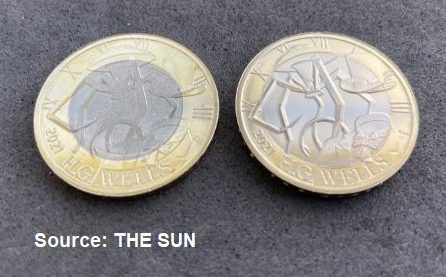
When striking £2 coins, the first step is to punch a hole through a blank planchet to create the outer section. The inner core is taken from a different metal, sized to fit inside the outer ring.
There have already been estimations that if this coin was to be sold at auction, it could fetch over £1,000! We’re going to be eagerly awaiting confirmation from The Royal Mint whether this error is genuine or not. Nonetheless, it certainly makes for interesting collecting!
This coin is yet to be individually issued, so any ‘error’ versions will have come exclusively from the 2021 UK Annual Set. It’ll certainly be interesting to see if any other stories crop up after the coin’s individual issue….
Whilst there are no identical examples to compare the H.G. Wells £2 ‘error’ to, there have been previous instances of the inner and outer sections of £2 coins not quite matching up:
Clipped Planchet

In the above image, the inner core was punched out from the end of the sheet of metal used for blanks, forming a straight or ragged edge clip.
Whilst this also occurs with monometallic coins, the pairing with an outer ring exposes a large gap which is much more noticeable.
The Royal Mint strike millions of coins each year so it is inevitable that variances will occur during the striking process and can’t always be picked up during quality control, despite the fact that this particular coin would weigh less than the standard 12g £2 coin.
Off Centre Inner Core

The inner core of this coin hasn’t been united properly prior to being struck, resulting in an off centre inner core.
Due to the way the inner and outer core are struck together with the two metals being lined up and then fused together during striking, a misalignment will mean that the inner core spills into the outer ring, as seen in the image above. There might also be a gap between the two metals on the opposing join.
Faulty Outer Ring

This particular mis-strike, shows a faulty planchet or outer ring, where the inner core is exposed.
In the image above, you can actually see the specific engineering design features where the inner core is grooved to help the metal flow bond to the outer ring and fuse during striking.
Similar to the first mis-strike we looked at, this could be caused by a clipped planchet, this time created when the outer ring was punched, however coins like this may also be caused by tampering post striking, for example by fakers trying to replace the inner core of a £2 with another coin to pass off as a rare error.
Bronze £2 Error
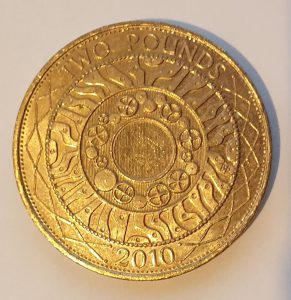
The ‘Monometallic’ £2 is described as the Holy Grail of bimetallic ‘errors’ and is the result of the nickel-brass £2 blank not having the inner core section punched out before being struck.
This means that the £2 coin is made from one full piece of nickel-brass, completely contrasting the very idea of a bimetallic coin.
A 2007 monometallic £2 was verified by The Royal Mint and in the email confirming the mis-strike it was mentioned that they had only seen 4-5 similar coins before.
However, in 2021, Change Checker was contacted by a collector called Amin who informed us that he had found this exact error coin but with a 2010 date.
After sending details of his coin to The Royal Mint for further information, it was confirmed to be genuine error as a result of the minting process.

This rare striking error is highly sought-after and coins have achieved extraordinary prices in private sales and auctions.
Whilst information of this coin’s sale has remained private, it’s certainly a very interesting story and we imagine the collector can expect to see a very impressive return on this coin…
We look forward to the individual release of the HG Wells £2 later this year and will certainly be keeping our eyes peeled for any unusual looking variations!
Have you ever come across any of these £2 error coins in your collection?
We’d love to know! Comment below.
Secure the 2021 UK Commemorative Coin Set – featuring the H. G. Wells £2!
The UK’s Top 10 Rarest Coins in Circulation
Which coins should you be looking out for in your change?
We’ve taken a look at the mintage figures for UK coins to find out which ones are the rarest in circulation...
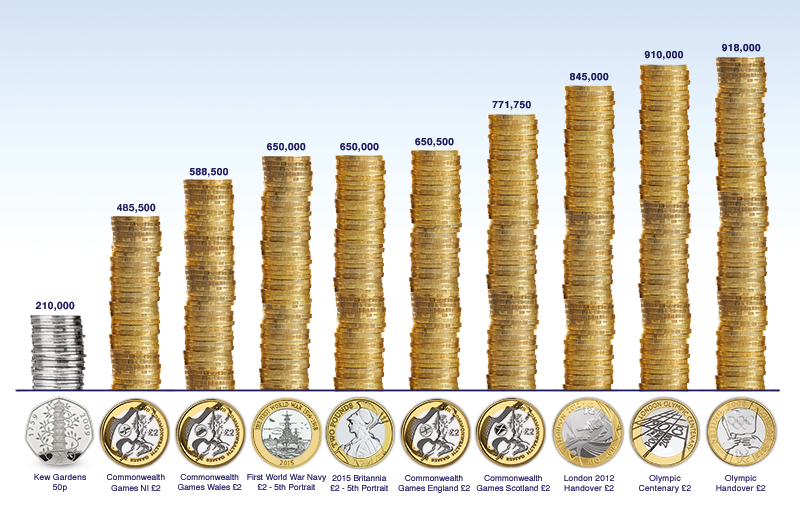
What you might be surprised by is that on our top 10 list, just 1 out of the 10 coins is a 50p!
The rarest UK coin currently in circulation is the Kew Gardens 50p, but the 9 rarest coins after that are actually £2s.
Whilst 50p coins are very popular amongst collectors at the moment, it’s certainly worth noting that it is in fact the £2 coins which you should be keeping your eyes peeled for, as some of the ones you can find in your change are very rare.
Other rare coins to look out for
Of course, this doesn’t take into account the rare error coins that have been found in circulation, such as:
- 2015 inverted effigy Britannia £2
- Olympic Aquatics 50p error
- Bronze 20p error
- Silver 2p error
- Undated 20p mule
Whilst exact mintage figures for these error coins may be unknown, we can assume that they could each be rare enough to find themselves near the top of the list.
A-Z of Great Britain 10p coins

It’s also worth noting that whilst mintage figures for the individual designs haven’t been released, if we assume that each A-Z of Great Britain 10p has been struck in equal quantities, then there would be approximately 281,000 of each design.
This would put each A-Z 10p design in equal second place on the list of the top 10 rarest coins in circulation!
What about the coins no longer in circulation?
Currently the Kew Gardens 50p is the rarest coin in circulation, but did you know that it isn’t actually the UK’s rarest 50p?
This title goes to the 1992/93 UK EC Presidency 50p, with a mintage of just 109,000 – almost half of the Kew Gardens!
In 1997, 50p coins were redesigned in the smaller specification and this coin was demonetised, meaning it is no longer in circulation.
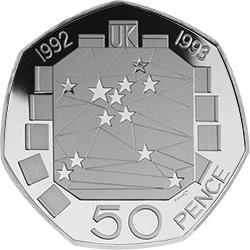
The same can be said of the 1989 Claim of Right £2, which was demonetized in 1997 when the bi-metallic £2 coin was introduced.
This coin has a mintage of 381,400 which makes it the rarest UK £2 and would put it in second place on the list if it were still in circulation.
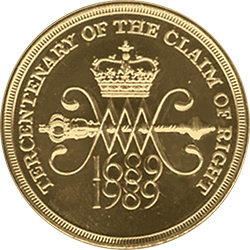
Are you lucky enough to have any of the top 10 rarest coins in your collection? Or perhaps you’ve even been lucky enough to get your hands on the pre-1997 coins listed above. Let us know in the comments below!
If you’re interested in coin collecting, our Change Checker web app is completely free to use and allows users to:
– Find and identify the coins in their pocket
– Collect and track the coins they have
– Swap their spare coins with other Change Checkers

Sign up today at: www.changechecker.org/app




